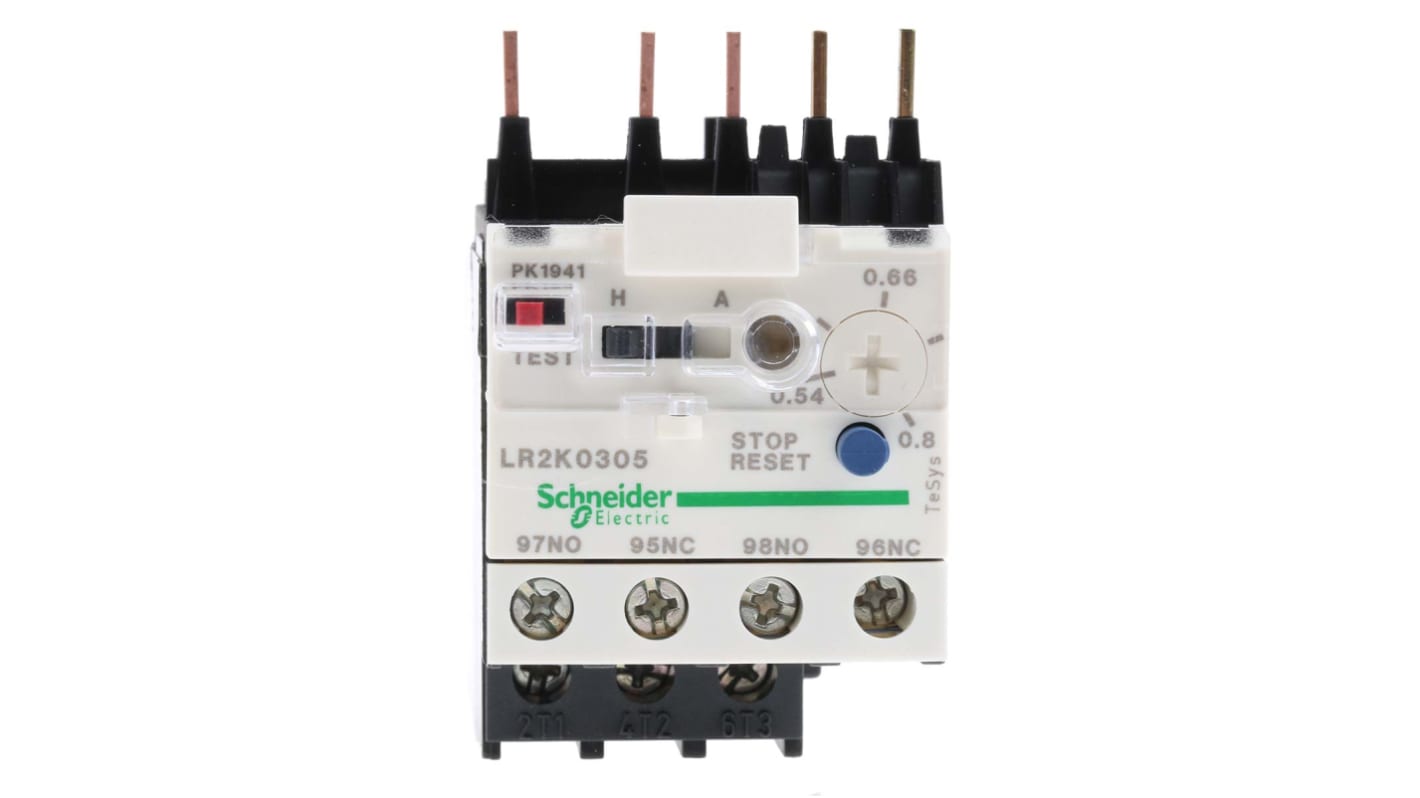Schneider Electric TeSyS LR Thermal Overload Relay 1NO + 1NC, 0.54 → 0.8 A F.L.C, 10 A Contact Rating, 100 W,
- RS Stock No.:
- 758-923
- Distrelec Article No.:
- 304-09-056
- Mfr. Part No.:
- LR2K0305
- Brand:
- Schneider Electric

Subtotal (1 unit)*
£42.67
(exc. VAT)
£51.20
(inc. VAT)
FREE delivery for orders over £50.00
In Stock
- 46 unit(s) ready to ship
- Plus 5 unit(s) ready to ship from another location
Need more? Click ‘Check delivery dates’ to find extra stock and lead times.
Units | Per unit |
|---|---|
| 1 + | £42.67 |
*price indicative
- RS Stock No.:
- 758-923
- Distrelec Article No.:
- 304-09-056
- Mfr. Part No.:
- LR2K0305
- Brand:
- Schneider Electric
Specifications
Technical Reference
Legislation and Compliance
Product Details
Find similar products by selecting one or more attributes.
Select all | Attribute | Value |
|---|---|---|
| Brand | Schneider Electric | |
| FLC Motor Rating | 0.54 → 0.8 A | |
| Contact Current Rating | 10 A | |
| Range | TeSys | |
| Pole Configuration | 3P | |
| Series | TeSyS LR | |
| Mounting Style | Direct Contactor | |
| Power Rating | 100 W | |
| Normal State Configuration | 1NO + 1NC | |
| Reset Method | Automatic, Manual | |
| Terminal Type | Screw | |
| Width | 45mm | |
| Number Of Auxiliary Contacts | 2 | |
| Length | 116mm | |
| Depth | 65mm | |
| Minimum Operating Temperature | -20°C | |
| Maximum Operating Temperature | +55°C | |
| Operating Temperature Range | -20 → +55 °C | |
| Contact Voltage Rating | 690 V ac | |
| Control Voltage | 250 V dc, 690 V ac | |
| Select all | ||
|---|---|---|
Brand Schneider Electric | ||
FLC Motor Rating 0.54 → 0.8 A | ||
Contact Current Rating 10 A | ||
Range TeSys | ||
Pole Configuration 3P | ||
Series TeSyS LR | ||
Mounting Style Direct Contactor | ||
Power Rating 100 W | ||
Normal State Configuration 1NO + 1NC | ||
Reset Method Automatic, Manual | ||
Terminal Type Screw | ||
Width 45mm | ||
Number Of Auxiliary Contacts 2 | ||
Length 116mm | ||
Depth 65mm | ||
Minimum Operating Temperature -20°C | ||
Maximum Operating Temperature +55°C | ||
Operating Temperature Range -20 → +55 °C | ||
Contact Voltage Rating 690 V ac | ||
Control Voltage 250 V dc, 690 V ac | ||
RoHS Status: Exempt
Schneider Electric Mini Thermal Overload Relays - LR2-K Range
Schneider Electrics K thermal overload relays are adjustable from 0.11 to 11.5 A, they have been predominantly designed for use in applications that require motor protection.
This range of mini thermal overload relays feature compensated and phase failure sensitivity, the range also offers manual and automatic reset. Each overload relay has 3-poles and screw clamp terminals.
This range of mini thermal overload relays feature compensated and phase failure sensitivity, the range also offers manual and automatic reset. Each overload relay has 3-poles and screw clamp terminals.
Features & Benefits
• Commonly referred to by the range short name - LR2K
• Easy maintenance checks, check the tightening of cables through conducting thermographic testing and checking the mechanical operation of the product through manually operating the test, reset and stop buttons
• Direct mounting under a contactor is achievable
• Standards - IEC 947, BS4941, VDE 0660, NFC63-650
• Standards - CSA, UL, DEMKO, NEMKO, SEMKO, FIMKO, PTB
• Easy maintenance checks, check the tightening of cables through conducting thermographic testing and checking the mechanical operation of the product through manually operating the test, reset and stop buttons
• Direct mounting under a contactor is achievable
• Standards - IEC 947, BS4941, VDE 0660, NFC63-650
• Standards - CSA, UL, DEMKO, NEMKO, SEMKO, FIMKO, PTB
Applications of a Contactor and Control Overload Relay
• The majority of the time is to protect a motor
• To detect both overload conditions and fault conditions to then announce trip command for a protective device
• To deactivate a device whenever it pulls high current
• Sometimes developed into microprocessor systems and solid-state electronics
• To detect both overload conditions and fault conditions to then announce trip command for a protective device
• To deactivate a device whenever it pulls high current
• Sometimes developed into microprocessor systems and solid-state electronics
